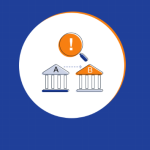Building a Strong Third-Party Risk Management Framework for Supplier Risk Control

In today’s globalized business environment, effective supplier risk management is crucial for ensuring operational continuity and minimizing risks linked to third-party relationships. A well-established third-party risk management (TPRM) framework provides a systematic approach to identifying, assessing, and managing risks from suppliers and other external entities. This article explores the key components of a TPRM framework, its advantages, and the best practices to implement a program that strengthens supplier risk management.
What is a Third-Party Risk Management Framework?
A third-party risk management framework is a structured process used to evaluate and manage risks associated with external suppliers, contractors, and service providers. It outlines the guidelines and procedures for managing risks throughout the life cycle of third-party relationships, ensuring that businesses mitigate potential threats while maintaining smooth operations.
Key Objectives of a TPRM Framework
- Risk Identification: Identify potential risks arising from third-party operations.
- Risk Assessment: Evaluate the severity and probability of identified risks.
- Mitigation Planning: Develop strategies to minimize or eliminate risks.
- Continuous Monitoring: Track third-party performance and risk indicators regularly.
Components of an Effective TPRM Framework
A comprehensive TPRM framework integrates several essential components to ensure robust risk management:
- Risk Identification and Categorization:
- Operational Risks: Evaluate a third party’s capability and reliability to deliver goods or services.
- Financial Risks: Assess the financial health and stability of third parties to prevent disruptions.
- Compliance Risks: Ensure adherence to legal, regulatory, and ethical standards.
- Cybersecurity Risks: Safeguard sensitive data from breaches and cyberattacks.
- Risk Assessment Tools:
- Tools like risk matrices or scoring models help prioritize risks based on their potential impact and likelihood.
- Contractual Safeguards:
- Clear and well-defined contracts set expectations and responsibilities, outlining consequences for non-compliance to mitigate risks from the outset of the relationship.
Understanding TPRM Programs
A TPRM program operationalizes the risk management framework by outlining specific steps for assessing, monitoring, and managing risks continuously.
Steps in a TPRM Program:
- Third-Party Onboarding: Use predefined risk assessment criteria to screen potential vendors or partners.
- Risk Categorization: Classify third parties based on their risk profiles.
- Due Diligence: Perform in-depth evaluations of operational, financial, and compliance risks.
- Ongoing Monitoring: Implement processes for real-time performance tracking of third-party entities.
Best Practices for Implementing a TPRM Framework
To ensure the success of a TPRM framework, businesses should follow these best practices:
- Centralized Risk Repository: Maintain a single, accessible database of all third-party risk profiles, making it easier to manage and update.
- Automation and Technology: Use digital tools to automate risk assessments, data collection, and ongoing monitoring.
- Collaboration with Stakeholders: Engage both internal teams and external vendors to foster transparency and shared responsibility in managing risks.
- Regular Audits and Reviews: Perform periodic assessments to evaluate the effectiveness of the TPRM framework and adjust to evolving risks.
The Importance of Cybersecurity in Third-Party Risk Management
Third-party relationships often require sharing sensitive business data, making cybersecurity an essential element of the TPRM framework. Protecting data from breaches or cyberattacks is critical in maintaining trust and regulatory compliance.
Cybersecurity Measures in TPRM:
- Implement multi-factor authentication and encryption to protect sensitive information.
- Ensure third parties follow industry-standard cybersecurity practices.
- Regularly conduct penetration testing and vulnerability assessments to identify weaknesses.
Benefits of an Effective Third-Party Risk Management Framework
A strong TPRM framework offers several key benefits:
- Enhanced Risk Visibility: Gain a clear understanding of the risks associated with each third-party relationship.
- Improved Compliance: Ensure compliance with regulatory standards, reducing the likelihood of penalties or reputational damage.
- Business Continuity: Minimize disruptions caused by third-party failures, ensuring that operations remain uninterrupted.
- Stronger Supplier Relationships: Promote transparency and cooperation with suppliers, improving the overall quality of third-party engagements.
Steps to Build a Resilient TPRM Framework
To build a robust TPRM framework, businesses must carefully plan and implement the following steps:
- Define Objectives: Align the TPRM framework with organizational goals and risk tolerance levels.
- Develop Policies and Procedures: Establish clear guidelines for assessing, monitoring, and mitigating third-party risks.
- Invest in Technology: Leverage advanced tools for data analysis, risk categorization, and vendor performance tracking.
- Train Stakeholders: Ensure all involved parties are properly trained on their roles in managing third-party risks.
- Measure Performance: Use key performance indicators (KPIs) to evaluate the effectiveness of the TPRM framework and identify areas for improvement.
Emerging Trends in Third-Party Risk Management
The landscape of third-party risk management continues to evolve, with new technologies and trends shaping the future of TPRM frameworks:
- Artificial Intelligence (AI) Integration: AI-powered tools can provide predictive insights and automate risk assessments, making the TPRM process more efficient and accurate.
- ESG (Environmental, Social, Governance) Metrics: As businesses focus more on sustainability, ESG factors are becoming increasingly important in third-party evaluations.
- Increased Regulatory Scrutiny: Governments and regulators are enforcing stricter guidelines for managing third-party risks, pushing companies to adopt more robust risk management frameworks.
- Blockchain for Transparency: Blockchain technology is being used to ensure secure and transparent tracking of vendor performance and compliance data.
Conclusion
A well-designed third-party risk management framework is essential for mitigating risks and maintaining strong supplier relationships. By incorporating the right tools, best practices, and continuous monitoring, businesses can build a resilient framework that not only minimizes risks but also enhances compliance and operational continuity.
As the global business environment grows more complex, investing in a robust TPRM framework is a critical step in navigating challenges and ensuring long-term success in supplier and vendor management.


 English
English 











































































































































































































































































































































































